This CE Center article is no longer eligible for receiving credits.
Thoughtful preservation of historic stonework. A sleek new glass facade married with modern steel elements. Your firm’s latest project for one of the city’s hottest restaurants is ready for its opening night. As a thank you, the design team is invited. Inside, the building glitters and the ambiance is perfect. You are commended by other guests on how well you captured the intent of the restaurateur. Your team feels proud of what it accomplished- until you overhear a few people commenting on how underwhelmed they were with the design and appointments in the washroom. The bathroom’s aesthetic fails to match the rest of the building’s design; materials feel cheap, and some of the layout is inconvenient.

All photos courtesy of ASI Group
Project: Port House
Location: Antwerp, Belgium
Architect: Zaha Hadid
A well-designed bathroom can be the deciding factor in elevating a building from good to great. Bathrooms, if given the requisite attention to detail, can make a much greater positive impact on the user’s experience within a building, thereby influencing their opinion of the business, the building owner, and the architects who designed the building. Inherent in every project is the human experience, both aesthetic and functional, that occupants have within the building. Attention frequently focuses on those elements involved in first impressions: facades, lobbies, and entryways. While storefronts can create a sense of awe and anticipation, the real working spaces that will generate lasting impressions are in the interior.
“It’s all about the restrooms!” proclaims Tom Peters in “The Little Big Things: 163 Ways to Pursue Excellence” (Harper Business, 2012). Why? Peters writes, “A sparkling restroom with family photos in a small restaurant in Gill, Massachusetts, shouts, ‘We care.’” Therefore, “the devil—and a culture that demands excellence—really is in the details!” He continues, “To me, a clean and attractive and even imaginative loo is the best...”
The same deliberate design that goes into the other parts of the building needs to carry through to the bathrooms: bathrooms are critical to the human experience. We inherently are asking people to do something very private in a public space, and almost all of our senses are engaged fully when we are in the bathroom even for such a short period of time. For occupants that interact with a building on a daily basis, the restroom performs a crucial function and is also a lynchpin for perception, one which also translates into their performance and productivity. For-first time patrons or visitors of a commercial space, the ‘bathroom experience’ can be the difference in whether they return or take their business elsewhere.
However, commercial restrooms are often relegated to an afterthought, a space designed and installed without a great deal of consideration for its impact on occupants and their experience. Bathrooms unfortunately become the weak link of the overall architectural experience of the building. Poor restroom design sets a very negative tone and interferes with the occupants’ perception of the entire building and business, regardless of how beautiful and functional the building may be in every other aspect. As many business owners know, the way their employees perceive the space in which they work is reflected in how they feel and perform.
Leon Shakeshaft, architect and partner, Arthur Gibney & Partners, Dublin, Ireland, notes, “Last year, I had the pleasure of having a private tour of one of New York’s landmark office buildings. As I appreciated the architecture and the thought that went into the details of the building, I found a lack of harmony between the design choices in the bathrooms when compared to the rest of the building. At our firm, we recognize that all things being equal, the quality of bathrooms can be the differentiating factor when our clients seek to attract tenants. Good bathroom design does not have to cost more, but it pays great dividends.”
“It’s all about the restrooms!” proclaims Tom Peters in “The Little Big Things: 163 Ways to Pursue Excellence” (Harper Business, 2012). Why? Peters writes, “A sparkling restroom with family photos in a small restaurant in Gill, Massachusetts, shouts, ‘We care.’” Therefore, “the devil—and a culture that demands excellence—really is in the details!” He continues, “To me, a clean and attractive and even imaginative loo is the best...”
Quantifying the Bathroom Experience: What Do Occupants Say?
People have very visceral responses to design decisions in commercial bathrooms. All five senses are engaged. Sounds in the bathroom play a very important role in how we feel. The way the bathroom looks aesthetically drives our perception of the space: Does the bathroom look clean and hygienic? Does it look like it is part of a cohesive design? Occupants expect that our bathrooms make them feel comfortable, safe, and private. Ensuring fundamental accessibility is crucial.
Restrooms impact building users in two primary ways: first, by their initial design, and second, by how they are maintained.
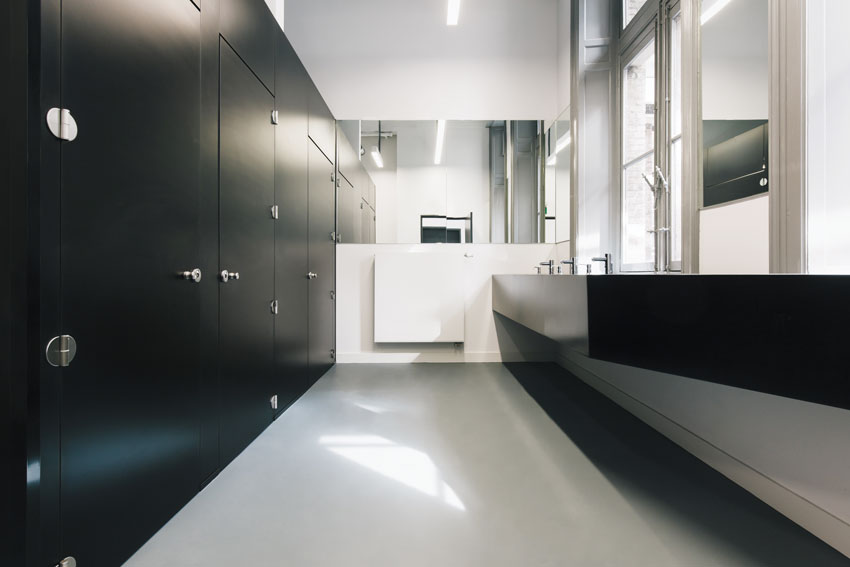
Iconic buildings deserve iconic washrooms.
Design can either support or get in the way of proper maintenance. “Restroom cleanliness is always one of the top five drivers of customer satisfaction,” reports Lysa Scully, Port Authority of New York & New Jersey. According to a survey by Zogby International, more than 80 percent of consumers would avoid a restaurant with a dirty restroom—not just avoid the restroom, but avoid the restaurant altogether.
An overwhelming majority—86 percent of U.S. adults—equate the cleanliness of a restaurant’s restroom with the cleanliness of its kitchen, according to a Harris Interactive poll. The survey also revealed that 75 percent of U.S. adults would not return to a restaurant with dirty restrooms. Regardless of industry, clean restrooms directly impact a business’s ability to attract and retain customers.
The poll drives home the importance of building user experience in the digital age. The survey found that 50 percent of people who encounter a dirty restroom would discuss it with friends and family. In today’s highly visible and ever-prevalent social media platforms, patrons “discuss” this with a much wider audience than in yester year. These types of reviews can cost a business potential customers, before many of them even set foot in the door.
Given the powerful impressions washrooms leave on consumers, businesses and building owners need to ensure that their facilities deliver.
A vast array of things—from bad lighting to too few toilets—may contribute to a user’s negative experience in a bathroom. Empty or jammed toilet paper dispensers, poor sanitation, smells, lack of privacy, trash on the floor, and empty soap and paper towel dispensers are among top occupant complaints.
While poorly maintained and designed bathrooms have an outsized negative effect on a building, clean bathrooms can suggest many positive things to customers: a clean washroom is an indication that the establishment itself is clean; that the owner and manager pay attention to details; that the building’s designer takes customers and their experience seriously; and ultimately, that customers can trust the business to take care of its customers.
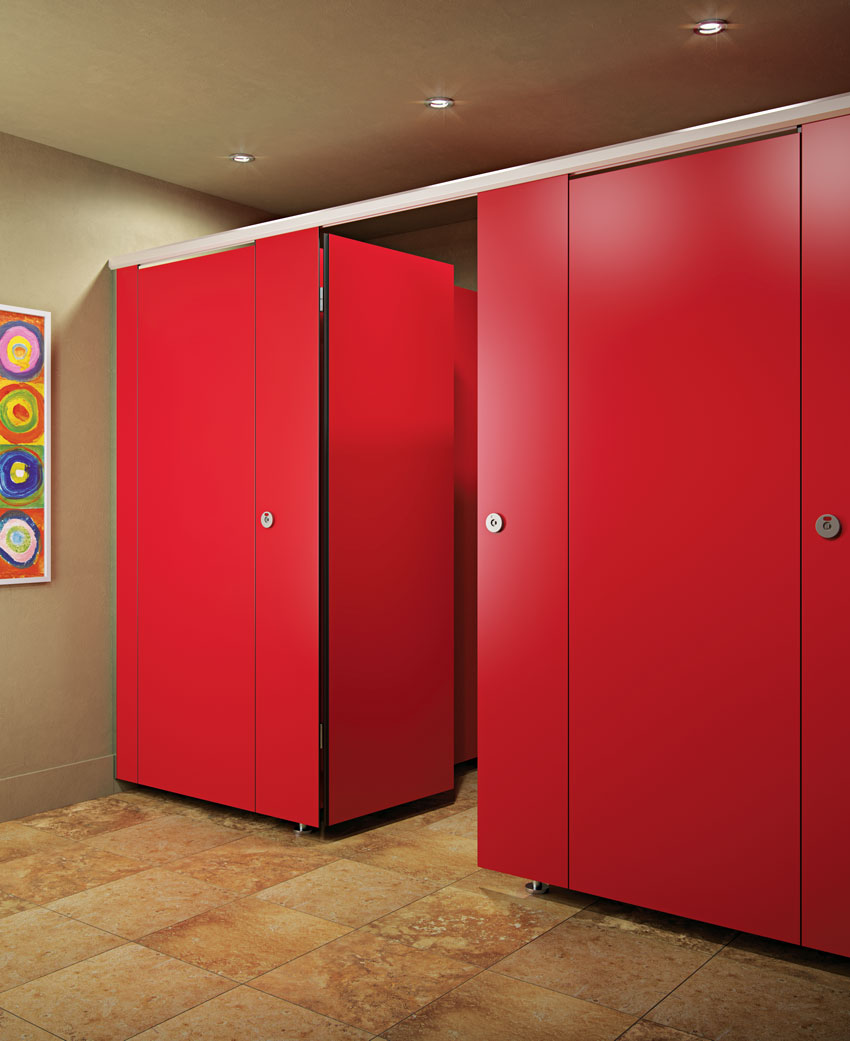
The design and upkeep of a restroom plays a crucial role in shaping the kind of relationship formed between building designer, owner, and occupants.
Thoughtful preservation of historic stonework. A sleek new glass facade married with modern steel elements. Your firm’s latest project for one of the city’s hottest restaurants is ready for its opening night. As a thank you, the design team is invited. Inside, the building glitters and the ambiance is perfect. You are commended by other guests on how well you captured the intent of the restaurateur. Your team feels proud of what it accomplished- until you overhear a few people commenting on how underwhelmed they were with the design and appointments in the washroom. The bathroom’s aesthetic fails to match the rest of the building’s design; materials feel cheap, and some of the layout is inconvenient.

All photos courtesy of ASI Group
Project: Port House
Location: Antwerp, Belgium
Architect: Zaha Hadid
A well-designed bathroom can be the deciding factor in elevating a building from good to great. Bathrooms, if given the requisite attention to detail, can make a much greater positive impact on the user’s experience within a building, thereby influencing their opinion of the business, the building owner, and the architects who designed the building. Inherent in every project is the human experience, both aesthetic and functional, that occupants have within the building. Attention frequently focuses on those elements involved in first impressions: facades, lobbies, and entryways. While storefronts can create a sense of awe and anticipation, the real working spaces that will generate lasting impressions are in the interior.
“It’s all about the restrooms!” proclaims Tom Peters in “The Little Big Things: 163 Ways to Pursue Excellence” (Harper Business, 2012). Why? Peters writes, “A sparkling restroom with family photos in a small restaurant in Gill, Massachusetts, shouts, ‘We care.’” Therefore, “the devil—and a culture that demands excellence—really is in the details!” He continues, “To me, a clean and attractive and even imaginative loo is the best...”
The same deliberate design that goes into the other parts of the building needs to carry through to the bathrooms: bathrooms are critical to the human experience. We inherently are asking people to do something very private in a public space, and almost all of our senses are engaged fully when we are in the bathroom even for such a short period of time. For occupants that interact with a building on a daily basis, the restroom performs a crucial function and is also a lynchpin for perception, one which also translates into their performance and productivity. For-first time patrons or visitors of a commercial space, the ‘bathroom experience’ can be the difference in whether they return or take their business elsewhere.
However, commercial restrooms are often relegated to an afterthought, a space designed and installed without a great deal of consideration for its impact on occupants and their experience. Bathrooms unfortunately become the weak link of the overall architectural experience of the building. Poor restroom design sets a very negative tone and interferes with the occupants’ perception of the entire building and business, regardless of how beautiful and functional the building may be in every other aspect. As many business owners know, the way their employees perceive the space in which they work is reflected in how they feel and perform.
Leon Shakeshaft, architect and partner, Arthur Gibney & Partners, Dublin, Ireland, notes, “Last year, I had the pleasure of having a private tour of one of New York’s landmark office buildings. As I appreciated the architecture and the thought that went into the details of the building, I found a lack of harmony between the design choices in the bathrooms when compared to the rest of the building. At our firm, we recognize that all things being equal, the quality of bathrooms can be the differentiating factor when our clients seek to attract tenants. Good bathroom design does not have to cost more, but it pays great dividends.”
“It’s all about the restrooms!” proclaims Tom Peters in “The Little Big Things: 163 Ways to Pursue Excellence” (Harper Business, 2012). Why? Peters writes, “A sparkling restroom with family photos in a small restaurant in Gill, Massachusetts, shouts, ‘We care.’” Therefore, “the devil—and a culture that demands excellence—really is in the details!” He continues, “To me, a clean and attractive and even imaginative loo is the best...”
Quantifying the Bathroom Experience: What Do Occupants Say?
People have very visceral responses to design decisions in commercial bathrooms. All five senses are engaged. Sounds in the bathroom play a very important role in how we feel. The way the bathroom looks aesthetically drives our perception of the space: Does the bathroom look clean and hygienic? Does it look like it is part of a cohesive design? Occupants expect that our bathrooms make them feel comfortable, safe, and private. Ensuring fundamental accessibility is crucial.
Restrooms impact building users in two primary ways: first, by their initial design, and second, by how they are maintained.

Iconic buildings deserve iconic washrooms.
Design can either support or get in the way of proper maintenance. “Restroom cleanliness is always one of the top five drivers of customer satisfaction,” reports Lysa Scully, Port Authority of New York & New Jersey. According to a survey by Zogby International, more than 80 percent of consumers would avoid a restaurant with a dirty restroom—not just avoid the restroom, but avoid the restaurant altogether.
An overwhelming majority—86 percent of U.S. adults—equate the cleanliness of a restaurant’s restroom with the cleanliness of its kitchen, according to a Harris Interactive poll. The survey also revealed that 75 percent of U.S. adults would not return to a restaurant with dirty restrooms. Regardless of industry, clean restrooms directly impact a business’s ability to attract and retain customers.
The poll drives home the importance of building user experience in the digital age. The survey found that 50 percent of people who encounter a dirty restroom would discuss it with friends and family. In today’s highly visible and ever-prevalent social media platforms, patrons “discuss” this with a much wider audience than in yester year. These types of reviews can cost a business potential customers, before many of them even set foot in the door.
Given the powerful impressions washrooms leave on consumers, businesses and building owners need to ensure that their facilities deliver.
A vast array of things—from bad lighting to too few toilets—may contribute to a user’s negative experience in a bathroom. Empty or jammed toilet paper dispensers, poor sanitation, smells, lack of privacy, trash on the floor, and empty soap and paper towel dispensers are among top occupant complaints.
While poorly maintained and designed bathrooms have an outsized negative effect on a building, clean bathrooms can suggest many positive things to customers: a clean washroom is an indication that the establishment itself is clean; that the owner and manager pay attention to details; that the building’s designer takes customers and their experience seriously; and ultimately, that customers can trust the business to take care of its customers.

The design and upkeep of a restroom plays a crucial role in shaping the kind of relationship formed between building designer, owner, and occupants.
Quantifying the Bathroom Experience: Just Why Are Bathrooms Important?
Modern design seeks to be self-aware and occupant centric. Given these values, modern offices eschew cubicles and instead create flex space to encourage visual, verbal, and nonverbal social interactions between coworkers. The merits of this move to open plans and the resulting lack of privacy is debatable. For many, the lack of a private space is very detrimental, and it can be argued that open offices take away from the collective productivity of an organization. Regardless of the merit of lack of privacy in an office setting, as we continue using the theme of occupant-centric building design, it is even more critical that we pay added attention to the single most private spaces in any building. Whereas some people are just mildly uncomfortable in a public washroom, some suffer so extremely that they physically can’t go in the presence of others. The public bathroom is a space that has deep-rooted behaviors and social rituals that we’ve all experienced, if not at the office, then out at restaurants, the mall, and airports.
Going to the restroom is a necessary element of everyone’s life and work dynamic. With this in mind, Work Design Magazine (March 8, 2016) writes, “It will come as little surprise that thoughtful attention to the design and management of restrooms is more significant than often recognized. It offers the ultimate opportunity for employers and office managers to ‘walk the talk’ of a high-performance work environment.”
Investment in spaces that are crucial to the occupant experience are seen as more transparent reflections of building owners’ values. The design and upkeep of a restroom plays a crucial role in shaping the kind of relationship formed between building designer, owner, and occupants.
A 2011 study by John Goins, Center for the Built Environment, University of California, Berkeley, and Mithra Moezzi, Portland State University, shows that the organization that provides a bathroom that is thoughtfully designed and features materials that wear well will be more positively evaluated than those that don’t. Poorly designed and managed spaces reflect poorly on the individuals and larger organization that provide them.
A University of Alberta study supports that “restroom cleanliness has a significant effect on people’s perceptions of a building’s overall cleanliness.”
Washroom experiences are so important to occupants, there are even websites dedicated to restroom discussion. “The Happiest Potties on Earth” is an entire discussion board devoted to rating restroom experiences at Disneyland and California Adventure.
One-hundred percent of the opinion of the building can be affected by less than 1 pecent of the cost of the building. This is a profound statement. Proper design in the restroom can impact the overall experience and opinion of the building.
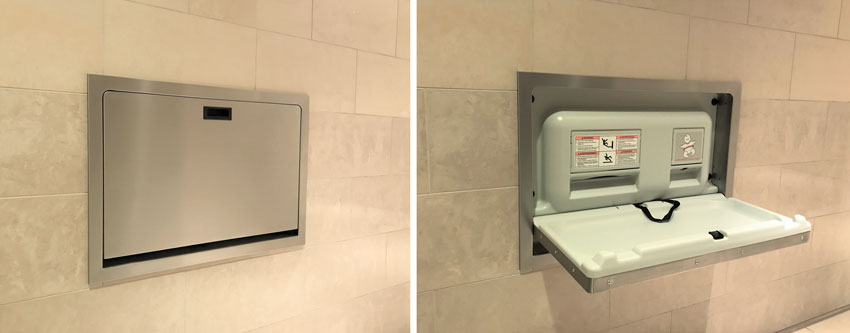
Changing stations at the Citifield Mets Stadium
One-hundred percent of the opinion of the building can be affected by less than 1 percent of the cost of the building. Proper design in the restroom—including the details, like accessories—can impact the overall experience and opinion of the building.
The Elements of Great Bathroom Design
Bathrooms designed for the optimal user experience can be the difference maker to the building owner who wants to rent space, or for the renter who wants customers to return and employees to perform at their best.
Practical considerations in bathrooms are crucial. Is the layout comfortable and accessible to a variety users? Does it accommodate higher traffic efficiently without sacrificing comfort? Does it accommodate strollers, wheelchairs, walkers, or luggage? Are the sightlines between partition walls and stall doors minimized? Does it have a cohesive style? Does is it look clean and hygienic? Will it be easy to maintain?
Today, most people living in developed countries expect privacy in the bathroom. Paradoxically, most bathrooms outside of private homes are designed for multiple, simultaneous occupants, writes Julie Beck in The Atlantic. Privacy and safety concerns are vital to a bathroom experience and must be addressed appropriately by the design team.
Touch and smell are critical to our peace of mind and play powerful roles in the perception of hygiene, cleanliness, and comfort. Particularly in public restrooms, occupants are hyper-aware of germs. The best design will carefully consider the surfaces an occupant has to touch and minimize contact with dirty surfaces. Are the fixtures touch free? Do the installed materials and fixtures promote ease of maintenance and inhibit the spread of germs and bacteria?
Because every project is unique, recycling specifications is the greatest cause of poor restroom design. Convincing building owners and managers to invest care and protect the budget for restrooms is vital to preserving the occupant experience.
Every building has a unique use type, and even different sections within the same building should be viewed through a different lens as it relates to the types of products and materials in bathrooms. When shopping for washroom accessories, toilet partitions, or even lockers, choice matters. A top criteria when choosing a manufacturer to partner with should be determining whether or not they have every type of material and product in their category, allowing a full suite of options with which create your vision.
Making Your Selections
The first step is identifying the restroom’s use based on building type and occupants. There are many different types of buildings and use cases. Each building needs to be viewed through a different lens to ensure that the right type of material and product are selected to optimize life cycle, create ease of maintenance, and ultimately provide the best customer experience. The types of products and materials used in bathroom furnishings for a university would vary greatly from that of a Class A office building, an aquatic facility, a restaurant restroom, or a high-frequency setting like that of a stadium or airport. Proper design reduces queuing, misuse, vandalism, initial costs, and maintenance costs.
High-demand facilities, like stadiums, that experience heavy volumes of users, must be designed to handle an extremely high volume of occupants. In this scenario, ensuring that the flow of the bathroom is seamless, allowing people to come and go while eliminating long lines, is crucial. There needs to be sufficient accessories, partitions, and flow to ensure that the bathroom functions appropriately. If restroom facilities are poorly designed, sports fans may stand in line and miss part of the ballgame and have a negative experience with the stadium, team, and sporting event. Long lines can also have a negative financial impact on the stadium owners, private or municipal, as patrons waste time waiting in line for the bathroom, rather than waiting in line at a concession stand.
Shortfall in design often occurs when designers operate from a series of specifications that are either adopted from previous projects or are a part of an outdated master specification. ADA and building codes change, necessitating specification evolution to account for both changes in code and design requirements and the introduction of innovative products.
The design landscape is ever evolving and relying on the past is not necessarily the optimal solution for a building owner. Even in a “budget bathroom” scenario, architects can use standard and basic materials in the right way to achieve great design on a low budget.
In addition to supporting overall building aesthetic and use, intelligent restroom design can also improve the performance of facility management in other meaningful ways, including through sustainability, cleanliness, and customer and employee safety.
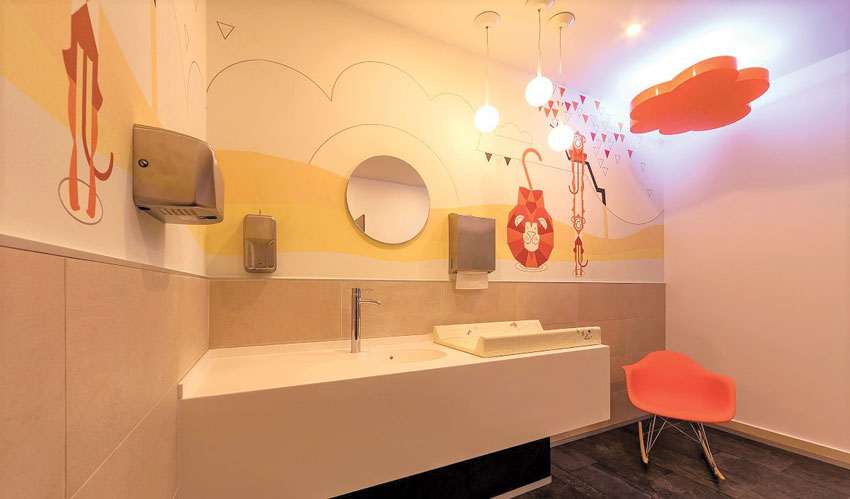
Project: Militiari Shopping Center
Loaction: Romania
Client: No Touch
Great bathrooms ask practical questions about user needs as well as aesthetics.
Universal Principles: Bathroom Design Checklist
Across the spectrum of bathroom design, there are universal principles we care about when it comes to restrooms, with each element interrelated and dependent on the others.
- Privacy: Privacy is vital in public restrooms and includes minimized sightlines in partitions, from doorways, and from mirrors. This is not an optional attribute. Fortunately, privacy can be ensured with good design and proper installation.
- Sustainability: Material specification plays a big in durability and longevity, as well as cleanliness and occupant experience. By creating facilities that are accessible, can be readily cleaned, and can withstand predicted use, a designer will not only facilitate required maintenance but also ensure that the project elements work together to maximize the serviceable life of the design. A well-designed bathroom with materials that last the intended life of the bathroom will avoid an early demise in a landfill. The right products for the right application mean maximal life.
- ADA code: When designing a public restroom facility, designers must be aware of elements required by code, such as ADA standards and comprehensive universal design principles. Attention should be given to:
- Circulation paths and maneuverability: As you move through the designed areas, carefully consider entrance to and travel about the restroom. Obstacles may need to be removed in order to create an acceptable passage width and circulation path. Partition layout and location of accessible toilet stalls become important here.
- Reach ranges: Consider users of all heights as well as wheelchair users. Mounting heights for sinks, hand dryers, grab bars, and other fixtures should be reachable and unobstructed for all users.
- Mirrors: Mirrors located above lavatories or countertops shall be installed with the bottom edge of the reflecting surface 40 inches maximum above the finish floor or ground.
- Door swings: Maneuvering clearances shall extend the full width of the doorway and the required latch-side or hinge-side clearance.
- Clear floor space: Lavatories should allow for open, easy approach.
- Interior finishes and materials fire standards: There are two standard test methods used to measure the fire performance of interior finishes. The first, ASTM E-84, tests the surface burning characteristics of building materials using a tunnel test method. The other standard is a room corner test, performed in accordance with NFPA 286, which measures the contribution of interior finish materials to room fire growth during specified fire exposure conditions.
- Maintenance: Making sure a space can be easily accessed and cleaned is a pivotal checkpoint for washroom design. Materials and systems must be maintained to be sustainable. Paying attention to material specification is vital because it will impact the durability, performance, and longevity of your restroom and also determine the maintenance schedule during operation.
- Hygiene: Does the overall design promote cleanliness? Are there antimicrobial materials incorporated in the design? Touch-free fixtures? Is it easy to maintain and keep clean?
- Lighting: Offer a combination of general lighting and task lighting that is flattering and complements the design and use of the space.
- Safety: Mitigate safety risks from hazards, such as wet floors. Wet floors are often a function of the location and number of drying stations in respect to sinks since water will drip from wet hands on the way to get them dry. Compounding this issue, some automatic hand dryers push water to the floor or have areas in the dryer where water can collect. Without a proper moisture management or drainage system, that water will overflow onto the floor or be a breeding ground for bacteria if it stays stagnant.
- Allowing for diversity: Understand that many buildings may require restrooms that need to cater to the special needs of people from different cultures or walks of life.
- Accommodate people with children of all ages, including those who need to have their diaper changed. This allows stadiums to be family friendly, particularly when enough changing stations are provided in both the men’s and women’s restrooms.
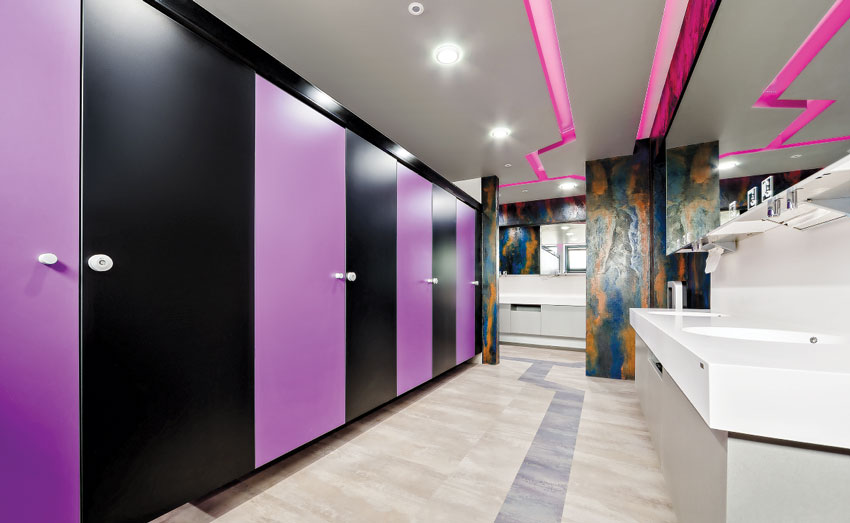
Project: ETU Auto Grill
Client: No Touch
Practical concerns, like safety, privacy, and accessibility, do not have to negate aesthetic goals.
Supporting Cast: Selecting the Best Elements to Enhance Your Design
Specifying Restroom Products and Materials
Beyond design and layout, making good product and material choices also plays directly into the overall user experience of restrooms and locker rooms. A seamless, fluid design creates an enjoyable, easy space. By carrying design through to accessories, the architect ensures that choices and material selections are complementary. This includes toilet partitions, lockers, washroom accessories, and plumbing fixtures. In that regard, it is important to work with manufacturers that can provide a variety of choices to meet the full range of needs in different restrooms. With an understanding of what the design goals are for your restroom, you and your team can make better-informed decisions about what products to specify and how.
Toilet Partitions
Toilet partitions make one of the biggest visual impacts in the restroom simply because they take up a lot of the real estate in a bathroom. They are also vital to user privacy. In his study of human behavior in public restrooms, sociologist and University of South Florida professor Spencer E. Cahill (et al.) notes that “toilet stalls in public bathrooms are publicly accessible yet private backstage regions.” Restrooms, and specifically toilet stalls, are where we take a break from social performances. It’s where we go to be alone, and it should meet that desire accordingly.
Additionally, of course, restrooms must be analyzed for volume of use, ease of maintenance, and potential levels of abuse to determine the proper layout, number of stalls required, and types of partitions that can create the best user experience possible. Take the time to design and efficiently place not only the partitions but the accessories that go with them. Design accessible partition systems with extra care as to dimensions and fixture locations.
There are a number of partition material options: powder coated, stainless steel, solid plastic, plastic laminate, and phenolic.
Powder Coated
Powder-coated partitions are the most common partition style in the United States. These are common because they are economical, fairly durable, provide a Class A fire rating, and are available in virtually any desired color. One of the advantages of powder-coated products is the large selections of choices based on color charts. Powder-coating facilities have the ability to match any color. However, these partitions are average when it comes to their vandalism rating, meaning they are easy to scratch, dent, and rust. The powder coating adds corrosion resistance to the galvanized steel, but these partitions should not be used in areas with high moisture content, such as shower rooms. Moisture is a primary consideration in the longevity of any product within the bathroom. The makeup of powder-coated steel partitions makes them low on the water-resistance scale.
Stainless Steel
Stainless steel is often perceived as a higher-cost, higher-end product that provides a very seamless and beautiful aesthetic. These partitions resist rust and are available in a variety of finishes, from standard satin finish to diamond pattern or leather grain. Stainless steel is Class A rated and is fairly vandal resistant, but a diamond texture finish can enhance vandal resistance. A leather-grained or diamond-grained texture can help conceal unsightly fingerprints, streaks, scratches, and impressions from daily use.
Stainless steel varies in gauge and type. Type 304 stainless steel is the standard for the washroom industry.
Nevertheless, some manufacturers may use a lesser grade of stainless with lower nickel and chromium levels. These lower content levels directly affect the corrosion resistance of the material and will lessen the life cycle of any accessory that is supplied in this manner. It is wise for designers or building owners to ask for certification of 304 stainless steel.
Solid Plastic
Solid plastic HDPE partitions are used in a variety of applications but are more critical in environments where moisture resistance is required. HDPE stands for high-density polyethylene, which is used in the production of plastic bottles and corrosion-resistant piping and is highly recyclable. Many HDPE partitions are manufactured using recycled content. The partitions are hydrophobic and completely moisture resistant, which makes them mold, mildew, and corrosion resistant and very easy to maintain. These partitions have a low susceptibility to dings and dents.
Solid plastic used in toilet partitions should meet the National Fire Protection Agency (NFPA) 286 standards.
While solid plastic is generally at the middle end of the cost spectrum, its high durability and moisture resistance make them an excellent choice in terms of sustainability, hygiene, longevity, and performance. Many designer colors are readily available, and selecting stock colors is recommended, especially for smaller jobs. Varying texture finishes are also available and can add something to your restroom aesthetic. Higher-textured finishes also typically increase the vandalism resistance.
Plastic Laminate
On the lower end of cost spectrum is plastic laminate. Plastic laminate is the least fire resistant of all the partition products. It has very low vandal resistance, and this material is fairly easy to graffiti, scratch, dent, and break. It is average on maintenance but very low on water resistance. The seams in the plastic laminate allow for water and moisture penetration and allow the MDF core and particle board to expand and absorb moisture, swell, and delaminate. However, some manufacturers have been able to overcome this challenge by creating a 3-millimeter edge banding that closes the seal seams and provides a beautiful seamless aesthetic as well increasing the longevity of moisture resistance by threefold. The other advantage many architects find in using plastic laminate apart from cost is its availability in a vast array of color.
Phenolic
A material that is becoming more prevalent in today’s market is phenolic. Phenolic bathroom partitions are comprised of a melamine sheet and multiple layers of resin-saturated craft paper pressed together in a high-compact laminate process. This produces an extremely vandal-resistant material that is highly durable. Phenolic comes in two options black core or color-thru. Color-thru provides a consistency throughout the phenolic. Overall phenolic is fire rated as Class B and sometimes A. It is very easy to maintain and is completely moisture resistant. Phenolic is often found in high-end buildings, swimming pool projects, and areas with frequent vandalism issues. Phenolic partitions have a seamless aesthetic appeal and offer many design options. They are available in a variety of privacy and mounting styles as well. Phenolic partitions offer a large range of colors.
European-Style Privacy Partitions
At the cutting edge of bathroom design, European Style Privacy Partitions have entered the mainstream in the United States over the past few years. These partitions are defined by their extra height for both doors and panels, designer hardware, built-in privacy to eliminate sightlines into the stall, and elegant designs. While typically used in higher-end office buildings and hotels, privacy partitions are gaining a foothold in school districts, entertainment facilities, and public and municipality facilities seeking to create a greater sense of privacy and safety for people from every walk of life.
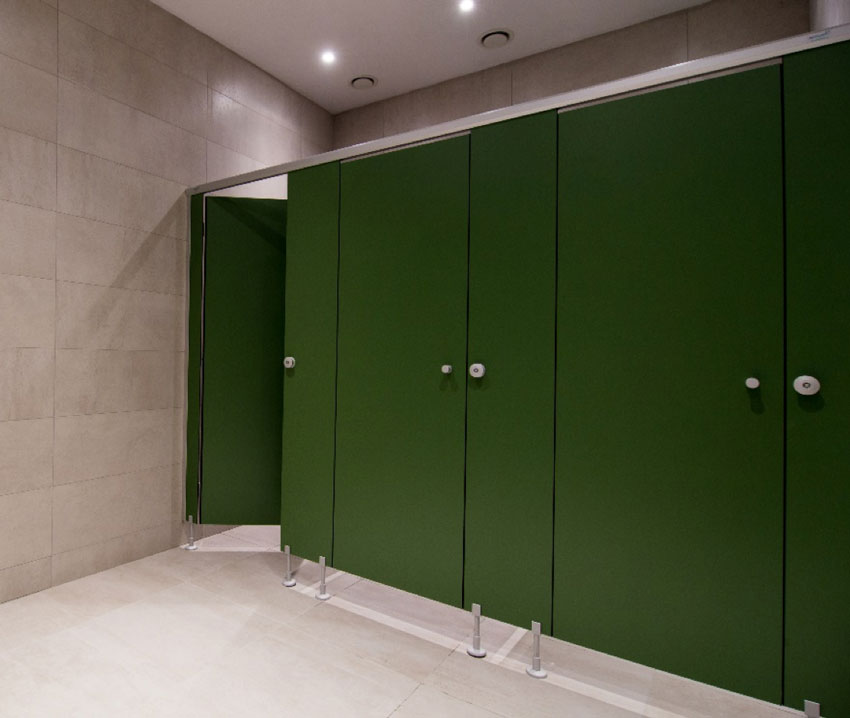
Privacy does not have to be an optional attribute in bathrooms. The availability of European-style partitions means greater options in design that take into account privacy for occupants.
Codes and Standards Related to Partitions
With the increased use of HDPE as a building material, the four code organizations concluded that ASTM E-84: Standard Test Method for Surface Burning Characteristics of Building Materials testing was insufficient. NFPA 286 is the preferred method because it is superior at determining the hazard of an interior finish, as opposed to the traditional tunnel test used in ASTM E-84. This is especially true when testing plastics that melt and fall to the floor of the ASTM E-84 tunnel. Moving forward, NFPA testing should be used.
Partition Attachment Methods
There are many options today for mounting toilet partitions: floor mounted, overhead braced, floor anchored, ceiling hung, or floor to ceiling. How partitions are mounted will also impact the amount of privacy and the aesthetic of your restroom. It may also impact the materials from which you can select.
Partition attachment also dictates privacy. The height of doors and panels affect privacy, so too do hinges and side fillers, which can eliminate sightlines into the compartment. Standard partitions have open sightlines on the side and bottom of each compartment. Using taller doors and privacy hinges eliminates this invasion of privacy.
Uneven floors or changes in wall dimensions during construction can cause gaps between the doors and pilasters and can even cause locking mechanisms to get compromised if the stalls are installed askew. If there is concern over these conditions occurring, specifying European-style partitions, with extra height on both doors and panels, adjustable pedestals to accommodate for uneven floors, superior hardware, and routed edges at sightlines between doors and pilasters can eliminate visibility into the stalls.
Fasteners, anchors, and blocking are critical to a sustainable installation. For example, even though solid plastic partition materials are easy to maintain, they are not as strong as metal. The hardware for this product must be very heavy duty and designed to distribute structural loads evenly across the system. Fasteners and partition panel hardware need to be coordinated with the substrate. A proper partition system is a combination of appropriate materials and hardware sized for the level of use in the toilet room.
Use your product manufacturer as a resource and seek out product manufacturers that offer multiple material and construction options so you can find the right solution for your specific design case.
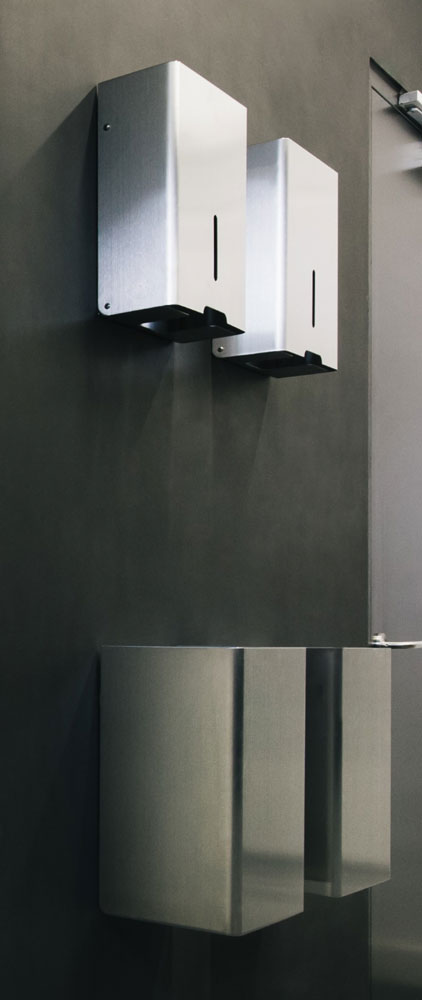
Careful selection of accessories means securing design, performance, and compliance for your washroom.
Toilet Room Accessories
Toilet room accessories are crucial to a successful restroom design and make a big impact on how your restroom is perceived. They also impact the ease of maintenance, so selecting the right products is important.
Often, details viewed as minor, like accessory choices, are left to a building manager. This can lead to mismatched selections and a disruption of aesthetics in the washroom. In the end, these post-design selections can cost more than those planned for installation at the product’s inception. Alternately, product selections may be made casually, without input or provision of proper certification from the manufacturer.
Stainless steel accessories are a go-to for durability and sleek appearance. Stainless steel also reduces the corrosiveness of the steel to various materials. Lower-grade steel will corrode much faster with various materials, a crucial note in relation to the cleaning agents that janitorial staff uses within the bathroom.
Stainless steel products vary in gauge, from 22 gauge, the baseline CSI specification, to 16 gauge, appropriate for high-use environments. Stainless Steel accessories are traditionally fabricated utilizing 304 stainless steel. This grade of stainless is the standard for the washroom industry.
Nevertheless, some manufacturers may use a lesser grade of stainless with lower nickel and chromium levels. These lower content levels directly affect the corrosion resistance of the material and will lessen the life cycle of any accessory that is supplied in this manner. It is wise for designers or building owners to ask for certification of 304 stainless steel. By carrying design through to accessories, the architect ensures that choices and material selections are complimentary.
Free dispensers or systems offered by consumable companies, like paper towel suppliers, take away from the overall design intent of the architect, may not be ADA compliant, and are aesthetically disruptive and cheaply made.
Manufacturers who provide accessory collections can help provide a unique solution for various project types, whether designing for a high-profile project or seeking a minimalist look. The number of accessories will of course depend on the number of stalls and volume of use.
Mirrors
Mirrors are also a design element that make a visual impact by their very nature. Mirrors can increase security by allowing a sightline from the entrance to the back of the restroom. Thoughtlessly placed mirrors, however, may provide a view from outside to areas where privacy was intended, such as the urinals in a men’s room, according to the American Restroom Association.
Mirrors are an important consideration to your restroom design. Building users may visit the restroom solely to use the mirror to check their appearance; inclusion of a full-body mirror in the design may be a consideration.
Hand Dryers and Paper Towel Dispensers
A current consideration in regard to sustainability in commercial restrooms is the hand dryers versus paper towels debate. It is generally perceived that hand dryers are more environmentally friendly and have a lower carbon footprint than paper does, but high-speed hand dryers are often loud and disruptive. This noise adds an element of stress to a space. Some dryers that collect water may be breeding grounds for germs and bacteria. Some dryer manufacturers use moisture management systems to eliminate stagnant water and also use a multilayer filter: carbon for odor, antimicrobial to eliminate bacteria, and HEPA to remove air particulates.
Specifying both not only gives users a choice, it can also help mitigate issues and drawbacks of using just one or the other. Paper towel usage is also managed. Paper towel dispensers can be filled according to janitorial schedules; patrons can always use the electric hand dryers when paper dispensers run out. Less wear and tear on both also means greater longevity of use and less maintenance. The debate between hand dryers and paper does not have to be an either/or, as both serve purposes and can be used either in concert in the same bathroom or individually in different bathrooms within the same building.
Waste Receptacles
Overflowing trash bins and waste receptacles can be a major issue for restroom cleanliness and, in turn, user experience. Specifying the right size and number of receptacles based on user volume is important. Fixed, recessed receptacles and locked receptacles can also help minimize vandalism.
Soap-Dispensing System
One of the challenges for any facility management team is to keep consumables filled, particularly during high-volume events or seasons. That includes keeping up with soap dispensers in restrooms. Specifying systems that make this maintenance task easy and cost effective ensures a better occupant experience in the restroom. Certain dispensing systems use a multi-feed, top-fill soap-dispensing method, allowing a maintenance person to refill up to six soap dispensers at once, using a fill-port located on the countertop. This saves both time and money and keeps the restroom performing as designed.
Having choice in washroom products and accessories allows for a premium selection that maximizes aesthetic and durability benefits in place. Choice also means the potential to utilize more than one type of material, if applicable, in a design. Don’t be afraid to use manufacturers as reference points in both installation and care. Design professionals must become familiar with maintenance procedures and materials if they are to protect their designs and create truly sustainable projects.
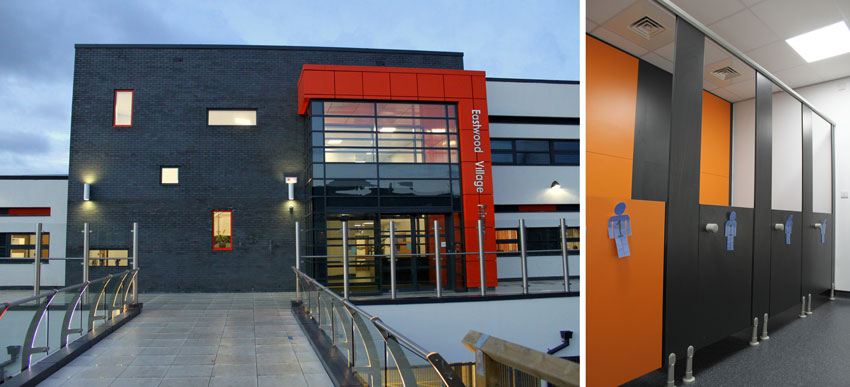
Project: Eastwood Primary School
Location: United Kingdom
The theme of the design is carried throughout, including into the restroom, at this U.K. primary school.
Supporting Cast: Realizing the Best Restroom Through Design Collaboration
Many elements and many pieces combine to create great restroom design. The key to successful restroom design is collaboration. The importance of working together with all parties stretches throughout the project: from understanding the owner’s needs, to crafting architectural design and adopting it to the design intent, to working with manufacturing to determine production capabilities, product range, and innovations, to finally working with the contractors in the field, collaborating between the various trades.
An integrative process for a well-designed bathroom goes beyond checklists and encourages collaboration during preliminary, predesign, and design development stages, when clarifying the owner’s aspirations, performance goals, and project needs will be most effective in improving performance. The integrative process measures performance and sets up feedback mechanisms. Feedback is critical to determining success in achieving performance targets, informing building operations, and taking corrective action when targets are missed.
Commercial bathrooms may have differing metrics that different constituents measure them by. It is incumbent on the architect who is trained to understand the needs of a variety of people affected by the design to balance design intent, cost, functionality, safety, environmental friendliness and a host of other critical areas to ensure the best outcome.
It is the architect who makes the case for what materials are used, what products get specified, and how much space and budget should be assigned to a restroom. How the architect pulls all this together will ultimately reflect on their own reputation and that of the building owner.
Architects and designers help shape our culture and society, and they have a greater responsibility than they receive credit for. They influence how people live, play, travel, work, behave, interact, dream, and feel about themselves and those who touch their lives. Architecture is more than memorable structures, beautiful entryways, and well-appointed landscapes. Architecture is about form meeting function in a way that both exist in a delicate balance that does not overpower the other.
Products and design that work well together result in sustainability. A sustainable washroom has a design professional behind it who thoughtfully planned a maintainable, durable design with an eye toward initial and total life-cycle cost and pleasing aesthetics. This forward thinking helps guarantee the longest possible life cycle of use for each component in the design: from partition material, to assembly construction, to individual hardware and accessories.
Considering the life cycle of the product means making a selection so that product doesn’t end up in a landfill. Use of appropriate materials is a significant part of developing a sustainable installation. Designing for maintainability over the life of a project is a key aspect of life-cycle cost. Despite everything we know about designing to first costs, we still find ourselves seeking to minimize the initial material costs. Having an excellent working relationship with manufacturers and suppliers offering multiple options allows a designer to have access to the very best selection for the unique project.
Similarly, having a choice in washroom partitions, washroom accessories, and lockers in a facility allows for a premium selection that maximizes aesthetic and durability benefits. Choice also means the potential to utilize more than one type of material, if applicable, in a design. Don’t be afraid to use manufacturers as reference points in both installation and care. Design professionals must become familiar with maintenance procedures and materials if they are to protect their designs and create truly sustainable projects. Maintenance should be first, not last. Most product installation manuals have some minimum discussion about maintenance and use of cleaning products.
It’s worthwhile noting that working with a manufacturer who provides a full spectrum of restroom products designed to complement each other can be a tremendous benefit to the cohesiveness of a design. Such manufacturers promote and support a comprehensive and cohesive approach to restroom design, so they will be valuable resource.
Paying attention to the details of the available products and systems on the market allows a restroom design to be optimized for users, maintenance, and cost effectiveness.
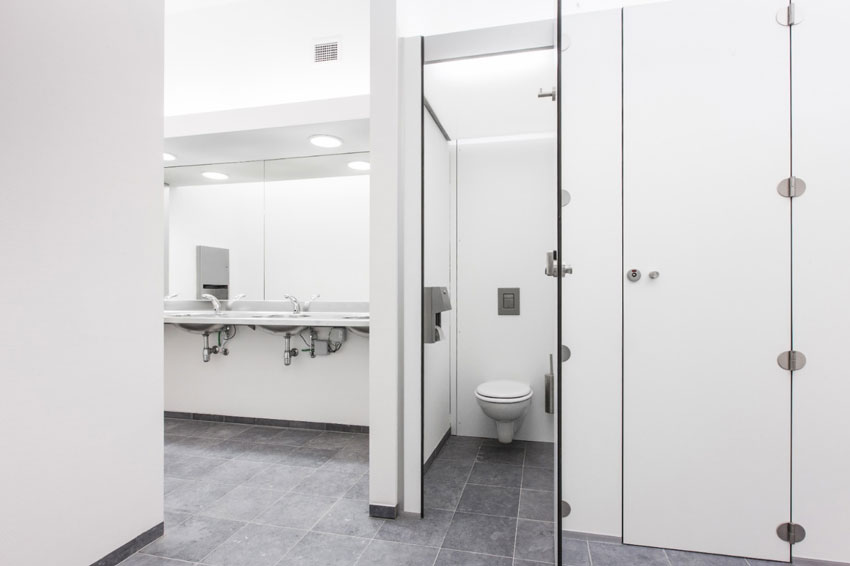
Project: Residence Palace
Location: Belgium
While it is hard to assign a monetary value to great restrooms, they have a real, tangible affect on building occupants.
Looking to the Future: Design Tools, Innovation, and Bathrooms
A well-designed bathroom can be the deciding factor in elevating a building from good to great. Bathrooms and lockers rooms are more private and personal and are used much more frequently than entryways and building facades. If given the requisite attention to detail, a well-thought-out bathroom can make a much greater positive impact on the user experience of a building.
Cyrus Boatwalla, director of marketing, ASI Group, notes that “a well-designed bathroom can be the deciding factor in elevating a building from good to great. Bathrooms and lockers rooms are more private and personal and are used much more frequently than entryways and building facades. If given the requisite attention to detail, a well-thought-out bathroom can make a much greater positive impact on the user experience of a building—thus influencing their opinion of the school, the town, and the architects who designed the building.”
Innovation is fostering design leaps in the bathroom, to the benefit of both the architect and the occupant.
Building products manufacturers can now provide detailed BIM 3-D drawings of their products, called BIM objects, on their websites.
“BIM enables closer collaboration between designers, contractors, subcontractors, and owners,” Boatwalla adds. “It also helps building products manufacturers work in more consultative ways with architects. We can help architects choose products that will provide the longest life cycle for the application. For instance, we would advise an architect to spec solid plastic or phenolic partitions for humid areas, such as shower stalls in locker rooms. The old-style plastic laminate is not ideal in moist or humid environments, although the newer ones with special moisture-resisitant edgebanding have a great durability in more humid environments.”
“We pull BIM objects off of websites all the time. BIM makes the design and construction process more integrated. It requires earlier decisions and executions, and it makes us work faster and more efficiently,” says Mike Schipp, AIA, CDT, LEED AP BD+C, a principal in the Indianapolis office of Fanning Howey, a national K-12 school planning and design firm.
BIM enables substantive collaboration and speeds the design and construction process both generally and in restrooms and locker rooms. Collaborative BIM designs are enhancing hygiene as well as vandalism resistance in restrooms and locker rooms.
Looking to the Future: A Pivotal Focus on Hygiene and Health
A topic foremost on everyone’s mind and driven into the spotlight by the COVID-19 pandemic, particularly in public spaces, is hygiene. A new battery of CDC guidelines recommends washing hands frequently if we are in a public space, or after sneezing, coughing, or blowing your nose. Older approaches to hygiene have left the design community wanting and new solutions and approaches are needed.
Thankfully, architects are often inspired to come up with fresh ideas during the midst of a crises—and there is not a much bigger one we have faced in our lifetime.
Cyrus Boatwalla, director of marketing, ASI Group, notes, “In the construction industry we need to plan for future Black Swan events—not just COVID-19. If we only plan to combat the types of pandemic we are facing now, we will be fighting a war based on yesterday’s experience. As our planet gets more populated and as we face the potential of harsher weather, we must build to a variety of different potential threats. Now is the time to take the blinders off, to use an old cliché, and to think of things we never thought of before or to anticipate events we thought would ‘never happen in my lifetime.’ Work with forward-thinking product manufacturers who will offer you a more complete pallet of products to choose from as you design our future.”
It may feel like there are more questions today than answers. Will design changes be legislated or market driven? How do we practically separate people while still allowing them to meet their fundamental need to be social? Can we expect more pandemics in the future or was this a once-in-a-hundred-year event?
Yet there are several guideposts to the future:
- Regardless of the specific questions, one can imagine that, moving forward, public spaces will be designed for minimum human contact, with more automation and touch free experiences actuated by voice command.
- Future designs may need to develop multipurpose, adaptable buildings, with built-in flexibility which would allow segments of a building to morph into use for different scenarios. There will be a move to retrofitting existing buildings so that areas of a building can be segregated to restrain the movement of people between departments.
- Public bathrooms where standard doors were once the norm will be altered wherever possible to eliminate the doors and create S-curve entrances.
- Hands-free technology in bathrooms will become the norm. Where there is inevitable contact with surfaces, designers will increasingly look out for antimicrobial products coatings and materials to frequently touched surfaces like doorknobs.
- There must be more opportunities for hand washing and sanitizing and an addition of mobile sanitizer stations.
- While in the past a building may have had a single main entrance, there will likely be multiple public entrances, along with the need for public bathrooms near each of those entrances.
- Building owners will need to add hygienic vending machines, or even well-designed dispensers for sanitizing wipes and liquids, to encourage employees to clean their own spaces more frequently. As building owners decide to install these dispensers, careful consideration should be given to whether those dispensers can dispense multiple brands' consumables so that they are not locked into the supply chain limitations of only one brand.
Iconic Buildings Deserve, Even Demand, Iconic Bathrooms
Overall, the latest innovations in restrooms are geared more and more toward elevating the user experience—a trend that should be supported by the overall restroom design. The quick pace of change in design and need to adapt to circumstances makes a trusted manufacturer relationship all the more vital to stay at the forefront of both design and product availability.
The human experience that is crucial to every architectural project. Buildings must be both functional and aesthetic. Ultimately, a building’s design will determine whether we have a positive or negative perception of that building, the building’s owners, and the business.
The underlying reality is that a cost is assigned to everything architects do. Modeling the cost to a building from poorly designed bathrooms versus great bathrooms could involve comparing rent per square foot from tenants, by calculation of sales or employee productivity, or even through studying student test scores. While the value of privacy or safety in bathrooms may be hard to calculate, surveys reveal it is a real value for building occupants. People feel better, safer, and more valued in buildings that have better bathrooms. Thoughtful bathrooms tangibly convey care for and the significance of users.
Amanda Voss, MPP, is an author, editor, and policy analyst. Writing for multiple publications, she also serves as the managing editor for Energy Design Update.
 |
ASI Group, comprised of American Specialties Inc., ASI Global Partitions, ASI Accurate Partitions, and ASI Storage Solutions, offers a single-source solution for washroom accessories, toilet partitions, lockers, and other storage products. www.asigroup.us |






















